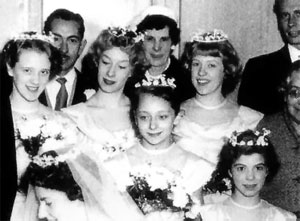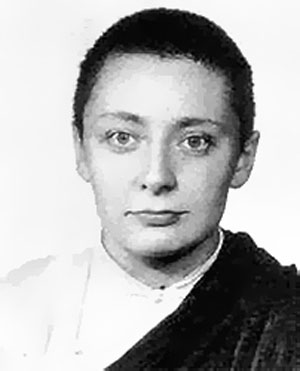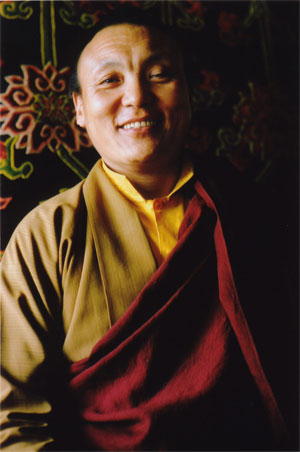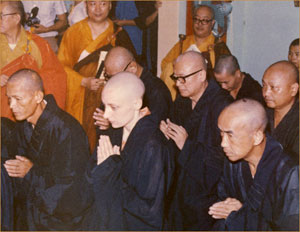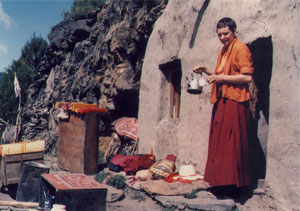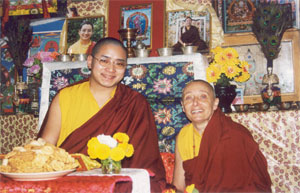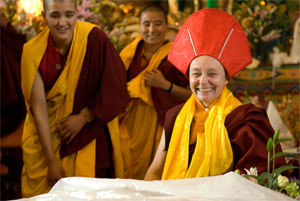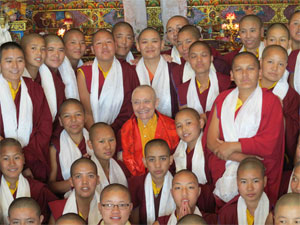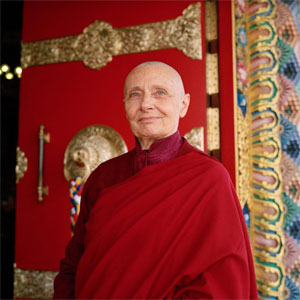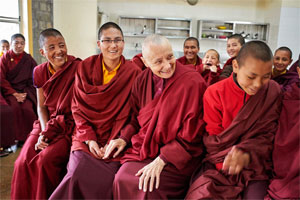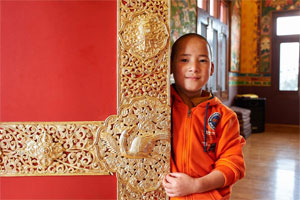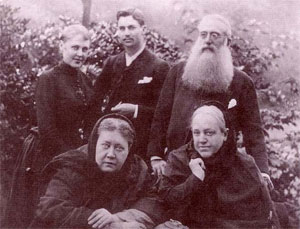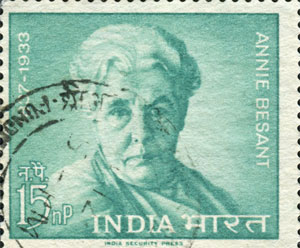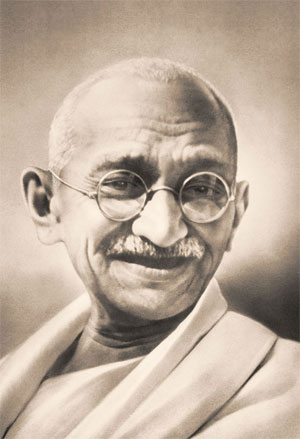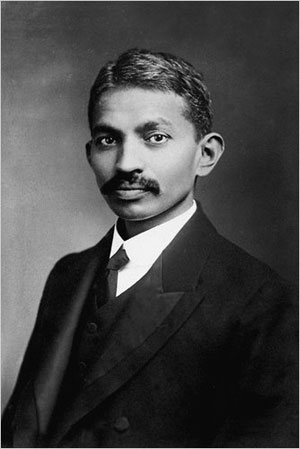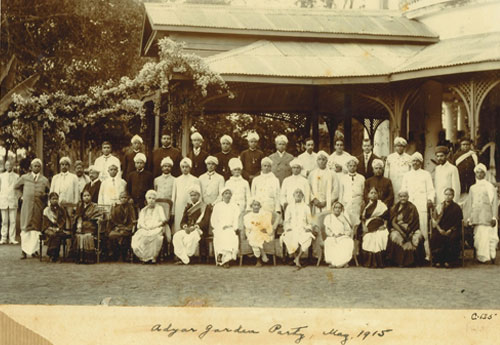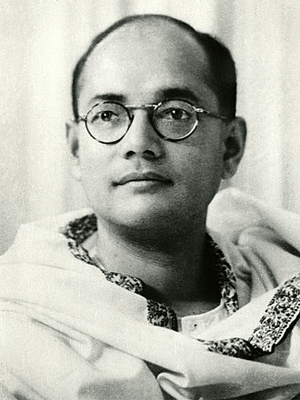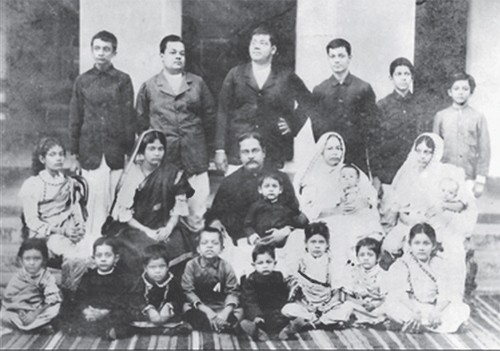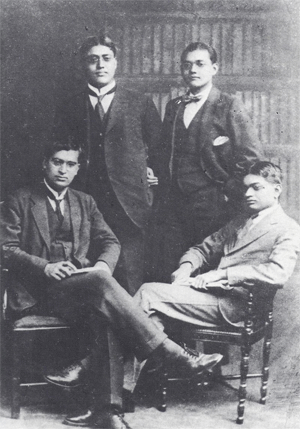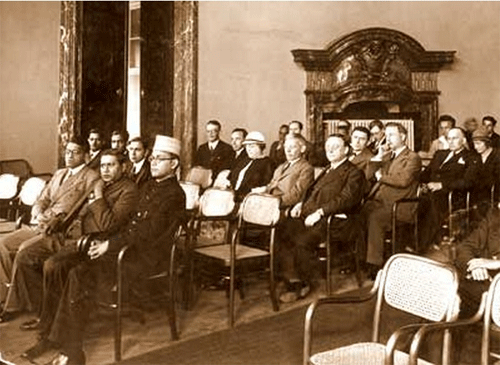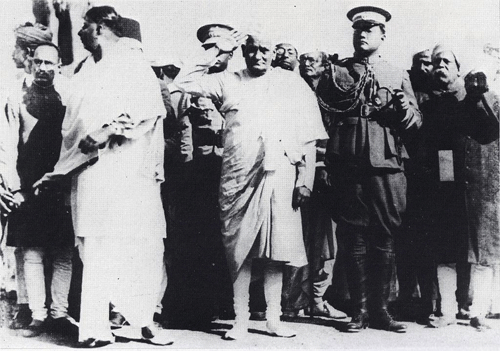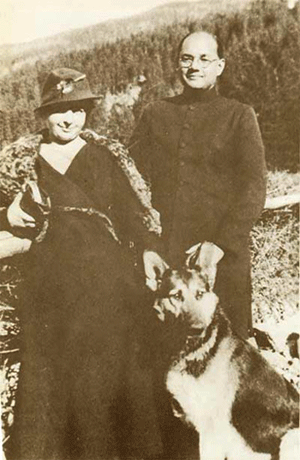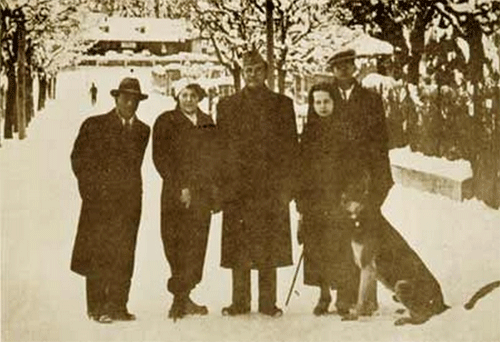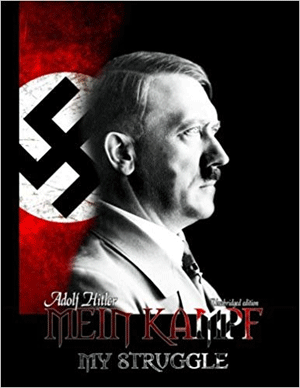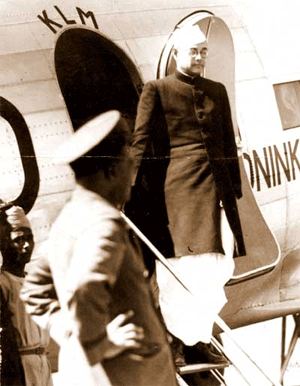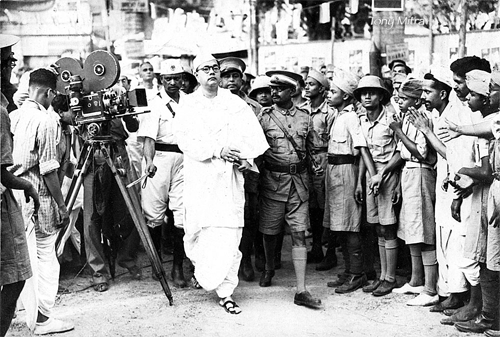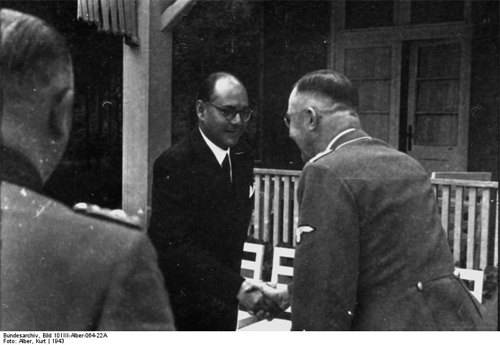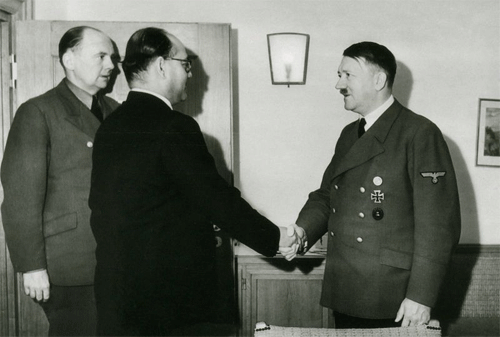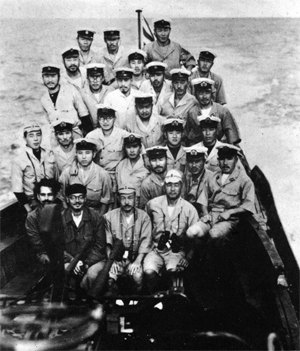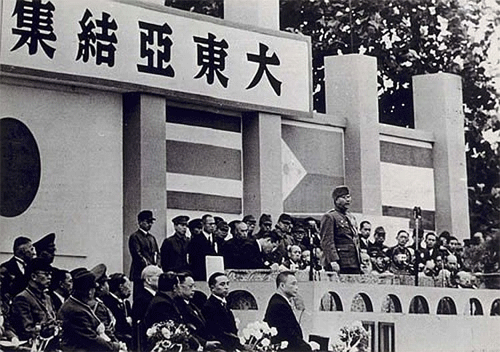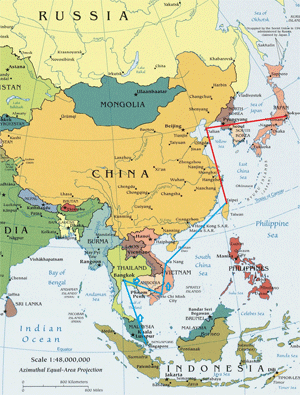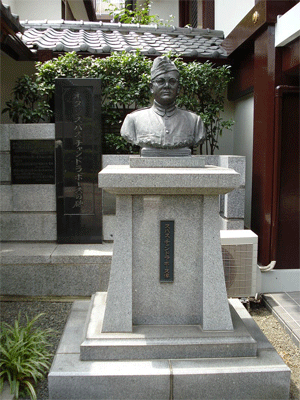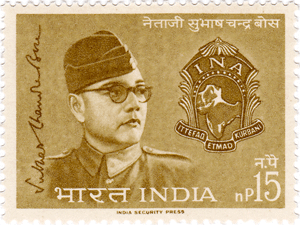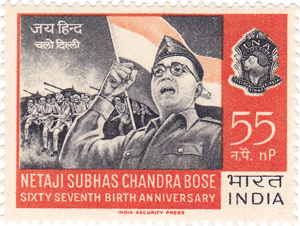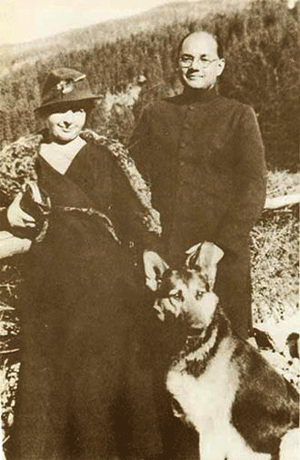 by admin » Tue Mar 26, 2019 12:15 am
by admin » Tue Mar 26, 2019 12:15 am
Part 2 of 2
Ideology
Bose advocated complete unconditional independence for India, whereas the All-India Congress Committee wanted it in phases, through Dominion status. Finally at the historic Lahore Congress convention, the Congress adopted Purna Swaraj (complete independence) as its motto. Gandhi was given rousing receptions wherever he went after Gandhi-Irwin pact. Subhas Chandra Bose, travelling with Gandhi in these endeavours, later wrote that the great enthusiasm he saw among the people enthused him tremendously and that he doubted if any other leader anywhere in the world received such a reception as Gandhi did during these travels across the country. He was imprisoned and expelled from India. Defying the ban, he came back to India and was imprisoned again.[citation needed]
Bose was elected president of the Indian National Congress for two consecutive terms, but had to resign from the post following ideological conflicts with Mohandas K. Gandhi and after openly attacking the Congress' foreign and internal policies. Bose believed that Gandhi's tactics of non-violence would never be sufficient to secure India's independence, and advocated violent resistance. He established a separate political party, the All India Forward Bloc and continued to call for the full and immediate independence of India from British rule. He was imprisoned by the British authorities eleven times.
His stance did not change with the outbreak of the Second World War, which he saw as an opportunity to take advantage of British weakness. At the outset of the war, he left India, travelling to the Soviet Union, Nazi Germany and Imperial Japan, seeking an alliance with each of them to attack the British government in India. With Imperial Japanese assistance, he re-organised and later led the Azad Hind Fauj or Indian National Army (INA), formed with Indian prisoners-of-war and plantation workers from British Malaya, Singapore, and other parts of Southeast Asia, against British forces. With Japanese monetary, political, diplomatic and military assistance, he formed the Azad Hind Government in exile, and regrouped and led the Indian National Army in failed military campaigns against the allies at Imphal and in Burma.
His political views and the alliances he made with Nazi and other militarist regimes at war with Britain have been the cause of arguments among historians and politicians, with some accusing him of fascist sympathies, while others in India have been more sympathetic towards the realpolitik that guided his social and political choices.
Subhas Chandra Bose believed that the Bhagavad Gita was a great source of inspiration for the struggle against the British.[86] Swami Vivekananda's teachings on universalism, his nationalist thoughts and his emphasis on social service and reform had all inspired Subhas Chandra Bose from his very young days. The fresh interpretation of the India's ancient scriptures had appealed immensely to him.[87] Many scholars believe that Hindu spirituality formed the essential part of his political and social thought throughout his adult life, although there was no sense of bigotry or orthodoxy in it.[88] Subhas who called himself a socialist, believed that socialism in India owed its origins to Swami Vivekananda.[89] As historian Leonard Gordon explains "Inner religious explorations continued to be a part of his adult life. This set him apart from the slowly growing number of atheistic socialists and communists who dotted the Indian landscape.".[90]
Bose first expressed his preference for "a synthesis of what modern Europe calls socialism and fascism" in a 1930 speech in Calcutta.[91] Bose later criticized Nehru's 1933 statement that there is "no middle road" between communism and fascism, describing it as "fundamentally wrong." Bose believed communism would not gain ground in India due to its rejection of nationalism and religion and suggested a "synthesis between communism and fascism" could take hold instead.[92] In 1944, Bose similarly stated, "Our philosophy should be a synthesis between National Socialism and communism."[93]
Bose's correspondence (prior to 1939) reflects his deep disapproval of the racist practices of, and annulment of democratic institutions in Nazi Germany: "Today I regret that I have to return to India with the conviction that the new nationalism of Germany is not only narrow and selfish but arrogant."[94] However, he expressed admiration for the authoritarian methods (though not the racial ideologies) which he saw in Italy and Germany during the 1930s, and thought they could be used in building an independent India.[51]
Bose had clearly expressed his belief that democracy was the best option for India.[95] The pro-Bose thinkers believe that his authoritarian control of the Azad Hind was based on political pragmatism and a post-colonial doctrine rather than any anti-democratic belief.[citation needed] However, during the war (and possibly as early as the 1930s), Bose seems to have decided that no democratic system could be adequate to overcome India's poverty and social inequalities, and he wrote that a socialist state similar to that of Soviet Russia (which he had also seen and admired) would be needed for the process of national re-building.[aa][96] Accordingly, some suggest that Bose's alliance with the Axis during the war was based on more than just pragmatism, and that Bose was a militant nationalist, though not a Nazi nor a Fascist, for he supported empowerment of women, secularism and other liberal ideas; alternatively, others consider he might have been using populist methods of mobilisation common to many post-colonial leaders.[51]
His most famous quote was "Give me blood and I will give you freedom".[97] Another famous quote was Dilli Chalo ("On to Delhi)!" This was the call he used to give the INA armies to motivate them. Jai Hind, or, "Glory to India!" was another slogan used by him and later adopted by the Government of India and the Indian Armed Forces. Another slogan coined by him was "Ittehad, Etemad, Qurbani" (Urdu for "Unity, Agreement, Sacrifice"). INA also used the slogan Inquilab Zindabad, which was coined by Maulana Hasrat Mohani.[98]
In popular media
• In 2004, Shyam Benegal directed the biographical film, Netaji Subhas Chandra Bose: The Forgotten Hero depicting his life in Nazi Germany (1941–1943), in Japanese-occupied Asia (1943–1945) and the events leading to the formation of Azad Hind Fauj.[99]The film received critical acclaim at the BFI London Film Festival, and has garnered the National Film Award for Best Feature Film on National Integration, and the National Film Award for Best Production Design for that year.[100][101]
• In 2017, ALTBalaji and BIG Synergy Media, released a 9-episode web series, Bose: Dead/Alive, which is a dramatised version of the book India's Biggest Cover-up written by Anuj Dhar, which starred Bollywood actor Rajkummar Rao as Subhas Chandra Bose and Anna Ador as Emilie Schenkl. The series was praised by both audience and critics, for its plot, performance and production design.[102]
See also
• The Indian Struggle
• Indian Independence Movement
• Indian National Army
Footnotes
Notes
1. ^ "If all else failed (Bose) wanted to become a prisoner of the Soviets: 'They are the only ones who will resist the British. My fate is with them. But as the Japanese plane took off from Taipei airport its engines faltered and then failed. Bose was badly burned in the crash. According to several witnesses, he died on 18 August in a Japanese military hospital, talking to the very last of India's freedom. British and Indian commissions later established convincingly that Bose had died in Taiwan. These were legendary and apocalyptic times, however. Having witnessed the first Indian leader to fight against the British since the great mutiny of 1857, many in both Southeast Asia and India refused to accept the loss of their hero. Rumours that Bose had survived and was waiting to come out of hiding and begin the final struggle for independence were rampant by the end of 1945.[1]
2. ^ "His romantic saga, coupled with his defiant nationalism, has made Bose a near-mythic figure, not only in his native Bengal, but across India."[2]
3. ^ "Bose's heroic endeavor still fires the imagination of many of his countrymen. But like a meteor which enters the earth's atmosphere, he burned brightly on the horizon for a brief moment only."[3]
4. ^ "Subhas Bose might have been a renegade leader who had challenged the authority of the Congress leadership and their principles. But in death he was a martyred patriot whose memory could be an ideal tool for political mobilization."[4]
5. ^ "The most troubling aspect of Bose's presence in Nazi Germany is not military or political but rather ethical. His alliance with the most genocidal regime in history poses serious dilemmas precisely because of his popularity and his having made a lifelong career of fighting the 'good cause'. How did a man who started his political career at the feet of Gandhi end up with Hitler, Mussolini, and Tojo? Even in the case of Mussolini and Tojo, the gravity of the dilemma pales in comparison to that posed by his association with Hitler and the Nazi leadership. The most disturbing issue, all too often ignored, is that in the many articles, minutes, memorandums, telegrams, letters, plans, and broadcasts Bose left behind in Germany, he did not express the slightest concern or sympathy for the millions who died in the concentration camps. Not one of his Berlin wartime associates or colleagues ever quotes him expressing any indignation. Not even when the horrors of Auschwitz and its satellite camps were exposed to the world upon being liberated by Soviet troops in early 1945, revealing publicly for the first time the genocidal nature of the Nazi regime, did Bose react."[5]
6. ^ "To many (Congress leaders), Bose's programme resembled that of the Japanese fascists, who were in the process of losing their gamble to achieve Asian ascendancy through war. Nevertheless, the success of his soldiers in Burma had stirred as much patriotic sentiment among Indians as the sacrifices of imprisoned Congress leaders.[6]
7. ^ "Marginalized within Congress and a target for British surveillance, Bose chose to embrace the fascist powers as allies against the British and fled India, first to Hitler's Germany, then, on a German submarine, to a Japanese-occupied Singapore. The force that he put together ... known as the Indian National Army (INA) and thus claiming to represent free India, saw action against the British in Burma but accomplished little toward the goal of a march on Delhi. ... Bose himself died in an aeroplane crash trying to reach Japanese-occupied territory in the last months of the war. ... It is this heroic, martial myth that is today remembered, rather than Bose's wartime vision of a free India under the authoritarian rule of someone like himself."[2]
8. ^ "Another small, but immediate, issue for the civilians in Berlin and the soldiers in training was how to address Subhas Bose. Vyas has given his view of how the term was adopted: 'one of our [soldier] boys came forward with "Hamare Neta". We improved upon it: "Netaji"... It must be mentioned, that Subhas Bose strongly disapproved of it. He began to yield only when he saw our military group ... firmly went on calling him "Netaji"' (Alexander) Werth also mentioned adoption of 'Netaji' and observed accurately, that it '... combined a sense both of affection and honour ...' It was not meant to echo 'Fuehrer' or 'Duce', but to give Subhas Bose a special Indian form of reverence and this term has been universally adopted by Indians everywhere in speaking about him."[7]
9. ^ "Jawaharlal Nehru and Subhas Bose were among those who, impatient with Gandhi's programmes and methods, looked upon socialism as an alternative for nationalistic policies capable of meeting the country's economic and social needs, as well as a link to potential international support."[8]
10. ^ "Although we must take Emilie Schenkl at her word (about her secret marriage to Bose in 1937), there are a few nagging doubts about an actual marriage ceremony because there is no document that I have seen and no testimony by any other person. ... Other biographers have written that Bose and Miss Schenkl were married in 1942, while Krishna Bose, implying 1941, leaves the date ambiguous. The strangest and most confusing testimony comes from A. C. N. Nambiar, who was with the couple in Badgastein briefly in 1937, and was with them in Berlin during the war as second-in-command to Bose. In an answer to my question about the marriage, he wrote to me in 1978: 'I cannot state anything definite about the marriage of Bose referred to by you, since I came to know of it only a good while after the end of the last world war ... I can imagine the marriage having been a very informal one ...'... So what are we left with? ... We know they had a close passionate relationship and that they had a child, Anita, born November 29, 1942, in Vienna. ... And we have Emilie Schenkl's testimony that they were married secretly in 1937. Whatever the precise dates, the most important thing is the relationship."[17]
11. ^ "Tojo turned over all his Indian POWs to Bose's command, and in October 1943 Bose announced the creation of a Provisional Government of Azad ("Free") India, of which he became head of state, prime minister, minister of war, and minister of foreign affairs. Some two million Indians were living in Southeast Asia when the Japanese seized control of that region, and these emigrees were the first "citizens" of that government, founded under the "protection" of Japan and headquartered on the "liberated" Andaman Islands. Bose declared war on the United States and Great Britain the day after his government was established. In January 1944 he moved his provisional capital to Rangoon and started his Indian National Army on their march north to the battle cry of the Meerut mutineers: "Chalo Delhi!"[21]
12. ^ "At the same time that the Japanese appreciated the firmness with which Bose's forces continued to fight, they were endlessly exasperated with him. A number of Japanese officers, even those like Fujiwara, who were devoted to the Indian cause, saw Bose as a military incompetent as well as an unrealistic and stubborn man who saw only his own needs and problems and could not see the larger picture of the war as the Japanese had to."[22]
13. ^ "Gracey consoled himself that Bose's Indian National Army had also been in action against his Indians and Gurkhas but had been roughly treated and almost annihilated; when the survivors tried to surrender, they tended to fall foul of the Gurkhas' dreaded kukri."[23]
14. ^ "The good news Wavell reported was that the RAF had just recently flown enough of its planes into Manipur's capital of Imphal to smash Netaji ("Leader") Subhas Chandra Bose's Indian National Army (INA) that had advanced to its outskirts before the monsoon began. Bose's INA consisted of about 20,000 of the British Indian soldiers captured by the Japanese in Singapore, who had volunteered to serve under Netaji Bose when he offered them "Freedom" if they were willing to risk their "Blood" to gain Indian independence a year earlier. The British considered Bose and his "army of traitors" no better than their Japanese sponsors, but to most of Bengal's 50 million Indians, Bose was a great national hero and potential "Liberator." The INA was stopped before entering Bengal, first by monsoon rains and then by the RAF, and forced to retreat, back through Burma and down its coast to the Malay peninsula. In May 1945, Bose would fly out of Saigon on an overloaded Japanese plane, headed for Taiwan, which crash-landed and burned. Bose suffered third-degree burns and died in the hospital on Formosa."[24]
15. ^ "The retreat was even more devastating, finally ending the dream of gaining Indian independence through military campaign. But Bose still remained optimistic, thought of regrouping after the Japanese surrender, contemplated seeking help from Soviet Russia. The Japanese agreed to provide him transport up to Manchuria from where he could travel to Russia. But on his way, on 18 August 1945 at Taihoku airport in Taiwan, he died in an air crash, which many Indians still believe never happened."[4]
16. ^ "There are still some in India today who believe that Bose remained alive and in Soviet custody, a once and future king of Indian independence. The legend of 'Netaii' Bose's survival helped bind together the defeated INA. In Bengal it became an assurance of the province's supreme importance in the liberation of the motherland. It sustained the morale of many across India and Southeast Asia who deplored the return of British power or felt alienated from the political settlement finally achieved by Gandhi and Nehru.[25]
17. ^ "On 21 March 1944, Subhas Bose and advanced units of the INA crossed the borders of India, entering Manipur, and by May they had advanced to the outskirts of that state's capital, Imphal. That was the closest Bose came to Bengal, where millions of his devoted followers awaited his army's "liberation." The British garrison at Imphal and its air arm withstood Bose's much larger force long enough for the monsoon rains to defer all possibility of warfare in that jungle region for the three months the British so desperately needed to strengthen their eastern wing. Bose had promised his men freedom in exchange for their blood, but the tide of battle turned against them after the 1944 rains, and in May 1945 the INA surrendered in Rangoon. Bose escaped on the last Japanese plane to leave Saigon, but he died in Formosa after a crash landing there in August. By that time, however, his death had been falsely reported so many times that a myth soon emerged in Bengal that Netaji Subhas Chandra was alive—raising another army in China or Tibet or the Soviet Union—and would return with it to "liberate" India.[26]
18. ^ "Subhas Bose was dead, killed in 1945 in a plane crash in the Far East, even though many of his devotees waited—as Barbarossa's disciples had done in another time and in another country—for their hero's second coming."[27]
19. ^ "The thrust of Sarkar's thought, like that of Chittaranjan Das and Subhas Bose, was to challenge the idea that 'the average Indian is indifferent to life', as R. K. Kumaria put it. India once possessed an energised, Machiavellian political culture. All it needed was a hero (rather than a Gandhi-style saint) to revive the culture and steer India to life and freedom through violent contentions of world forces (vishwa shakti) represented in imperialism, fascism and socialism."[28]
20. ^ "The (Japanese) Fifteenth Army, commanded by ... Maj.-General Mutuguchi Renya consisted of three experienced infantry divisions — 15th, 31st and 33rd — totalling 100,000 combat troops, with the 7,000 strong 1st Indian National Army (INA) Division in support. It was hoped the latter would subvert the Indian Army's loyalty and precipitate a popular rising in British India, but in reality the campaign revealed that it was largely a paper tiger."[30]
21. ^ "The real fault, however, must attach to the Japanese commander-in-chief Kawabe. Dithering, ... prostrated with amoebic dysentery, he periodically reasoned that he must cancel Operation U-Go in its entirety, but every time he summoned the courage to do so, a cable would arrive from Tokyo stressing the paramount necessity of victory in Burma, to compensate for the disasters in the Pacific. ... Even more incredibly, he still hoped for great things from Bose and the INA, despite all the evidence that both were busted flushes."[31]
22. ^ "The claim is even made that without the Japanese-influenced 'Indian National Army' under Subhas Chandra Bose, India would not have achieved independence in 1947; though those who make claim seem unaware of the mood of the British people in 1945 and of the attitude of the newly-elected Labour government to the Indian question."[32]
23. ^ "Janakinath was a lawyer of a Kayastha family and was wealthy enough to educate his children well.He recalls being laughed at by his fellow studentsbecause he knew so little Bengali. At the age of fifteen, he first read the works of Swami Vivekananda and found a goal for his life-spiritual salvation foroneself and service to humanity.[33]
24. ^ "On November 4, 1937, Subhas sent a letter to Emilie in German, saying that he would probably travel to Europe in the middle of November. "Please write to Kurhaus Hochland, Badgastein," he instructed her, "and enquire if I (and you also) can stay there" He asked her to mention this message only to her parents, not to reply, and wait for his next airmail letter or telegram. On November 16, he sent a cable: "Starting aeroplane arriving Badgastein twenty second arrange lodging and meet me. ... He spent a month and a half—from November 22, 1937, to January 8, 1938—with Emilie at his favourite resort of Badgastein."[45]
25. ^ "On December 26, 1937, Subhas Chandra Bose secretly married Emilie Schenkl. Despite the obvious anguish, they chose to keep their relationship and marriage a closely guarded secret."[46]
26. ^ "Rumours that Bose had survived and was waiting to come out of hiding and begin the final struggle for independence were rampant by the end of 1945."[1]
27. ^ "The Fundamental Problems of India" (An address to the Faculty and students of Tokyo University, November 1944): "You cannot have a so-called democratic system, if that system has to put through economic reforms on a socialistic basis. Therefore we must have a political system – a State – of an authoritarian character. We have had some experience of democratic institutions in India and we have also studied the working of democratic institutions in countries like France, England and United States of America. And we have come to the conclusion that with a democratic system we cannot solve the problems of Free India. Therefore, modern progressive thought in India is in favour of a State of an authoritarian character"[96]
References
1. ^ :a b c d e f Bayly & Harper 2007, p. 2.
2. ^ :a b c d e f Metcalf & Metcalf 2012, p. 210.
3. ^ :a b Kulke & Rothermund 2004, p. 311.
4. ^ :a b c d e Bandyopādhyāẏa 2004, p. 427.
5. ^ :a b Hayes 2011, p. 165.
6. ^ :a b Stein 2010, pp. 345.
7. ^ :a b Gordon 1990, pp. 459–460.
8. ^ :a b Stein 2010, pp. 305,325.
9. ^ Low 2002, p. 297.
10. ^ Low 2002, p. 313.
11. ^ :a b Hayes 2011, pp. 65–67.
12. ^ Hayes 2011, p. 152.
13. ^ Hayes 2011, p. 76.
14. ^ Hayes 2011, pp. 87–88.
15. ^ Hayes 2011, pp. 114–116.
16. ^ :a b Hayes 2011, p. 15.
17. ^ :a b Gordon 1990, pp. 344–345.
18. ^ :a b Hayes 2011, pp. 141–143.
19. ^ Bose 2005, p. 255.
20. ^ :a b Low 1993, pp. 31–31.
21. ^ :a b Wolpert 2000, p. 339.
22. ^ :a b Gordon 1990, p. 517.
23. ^ :a b McLynn 2011, pp. 295–296.
24. ^ :a b Wolpert 2009, p. 69.
25. ^ :a b c Bayly & Harper 2007, p. 22.
26. ^ :a b c Wolpert 2000, pp. 339–340.
27. ^ :a b Chatterji 2007, p. 278.
28. ^ :a b Bayly 2012, p. 283.
29. ^ :a b c d e f g Bayly & Harper 2007, p. 21.
30. ^ :a b Moreman 2013, pp. 124–125.
31. ^ :a b McLynn 2011, p. 429.
32. ^ :a b Allen 2012, p. 179.
33. ^ :a b c d e f g Lebra 2008a, pp. 102—103.
34. ^ Getz 2002, p. 7.
35. ^ Jesudasen 2006, p. 57.
36. ^ Patil 1988.
37. ^ Mercado 2002, p. 73.
38. ^ Vas 2008, p. 27.
39. ^ Toye 2007.
40. ^ Chakraborty & Bhaṭṭācārya 1989.
41. ^ Vas 2008, p. 32.
42. ^ :a b Vipul 2009, p. 116.
43. ^ :a b c Gordon 1990, p. 190.
44. ^ Bose & Bose 1997.
45. ^ Bose 2011, p. 127.
46. ^ Bose 2011, pp. 129–130.
47. ^ Josh 1992.
48. ^ Chattopadhyay 1989.
49. ^ Phadnis 2009, p. 185.
50. ^ Padhy 2011, p. 234.
51. ^ :a b c Sen 1999.
52. ^ Durga Das Pvt. Ltd 1985.
53. ^ Loiwal 2017a.
54. ^ Loiwal 2017b.
55. ^ :a b c d e Talwar 1976.
56. ^ :a b c d e Markandeya 1990.
57. ^ James 1997, p. 554.
58. ^ :a b c Thomson 2004.
59. ^ Majumdar 1997, pp. 10–14.
60. ^ Encyclopædia Britannica 2016.
61. ^ Hauner 1981, pp. 28–29.
62. ^ Ramakrishnan 2001.
63. ^ Bhattacharjee 2012.
64. ^ Fay 1995, pp. 74–75.
65. ^ Lebra 2008a, pp. 21–23.
66. ^ Lebra 2008a, pp. 24–25.
67. ^ Bose 2002.
68. ^ Tarique.
69. ^ Singh, p. 249.
70. ^ Bayly & Harper 2007, p. 325.
71. ^ "Father of Our Nation" (Address to Mahatma Gandhi over the Rangoon Radio on 6 July 1944) Bose & Bose 1997a, pp. 301–2
72. ^ :a b c Gordon 1990, p. 540.
73. ^ Fay 1995, p. 384.
74. ^ :a b c d e f g h i j Lebra 2008a, pp. 196–197.
75. ^ Lebra 2008a, pp. 195–196.
76. ^ :a b c d e f Gordon 1990, p. 541.
77. ^ :a b c Gordon 1990, pp. 541–542.
78. ^ :a b c Gordon 1990, p. 542.
79. ^ Gordon 1990, p. 543.
80. ^ Gordon 1990, p. 544–545.
81. ^ Lebra 2008a, pp. 197–198.
82. ^ :a b Gordon 1990, p. 545.
83. ^ Media related to Subhas Chandra Bose on stamps at Wikimedia Commons
84. ^ :a b Roche 2007.
85. ^ :a b The Hindu 2007.
86. ^ Narangoa & Cribb 2003.
87. ^ Bose et al. 1996.
88. ^ Chaudhuri 1987.
89. ^ Bhuyan 2003.
90. ^ Gordon 1990.
91. ^ Pasricha 2008, pp. 64–65.
92. ^ Bose 2011, p. 98.
93. ^ Shanker Kapoor 2017.
94. ^ Bose to Dr. Thierfelder of the Deutsche Academie, Kurhaus Hochland, Badgastein, 25 March 1936 Bose & Bose 1997a, p. 155
95. ^ Roy 2004, pp. 7–8.
96. ^ :a b Bose & Bose 1997a, pp. 319–20.
97. ^ Kumar 2010b.
98. ^ Roy 1996, pp. 51ff.
99. ^ Salam 2005.
100. ^ Pandohar 2005.
101. ^ The Guardian 2005.
102. ^ Gauri 2017.
Bibliography
• Allen, Louis (2012), "The Campaigns in Asia and the Pacific", in John Gooch, Decisive Campaigns of the Second World War, London: Routledge, pp. 162–191, ISBN 978-1-136-28888-3
• Bandyopādhyāẏa, Śekhara (2004), From Plassey to Partition: A History of Modern India, Orient Blackswan, ISBN 978-81-250-2596-2
• Bhattacharjee, CS (23 January 2012), "World believes Netaji was married, but not his party", The Sunday Indian, Kolkata, retrieved 13 February 2016
• Bayly, Christopher Alan (2012), Recovering Liberties: Indian Thought in the Age of Liberalism and Empire, Cambridge University Press, ISBN 978-1-139-50518-5
• Bayly, Christopher; Harper, Timothy (2007), Forgotten Wars: Freedom and Revolution in Southeast Asia, Harvard University Press, ISBN 978-0-674-02153-2
• Bhuyan, P. R. (2003), Swami Vivekananda, Atlantic Publishers & Distributors
• Bose, Madhuri (10 February 2014), "Emilie Schenkl, Mrs Subhas Chandra Bose", Outlook, retrieved 28 December 2018
• Bose, Sarmila (2005), "Love in the Time of War: Subhas Chandra Bose's Journeys to Nazi Germany (1941) and towards the Soviet Union (1945)", Economic and Political Weekly, 40 (3): 249–56, JSTOR 4416082
• Bose, Sisir; Bose, Sugata (1997), "The India Struggle", Hindustan Times, archived from the original on 10 April 2012, retrieved 6 February 2016
• Bose, Sisir; Bose, Sugata, eds. (1997a), The Essential Writings of Netaji Subhas Chandra Bose, Delhi: Oxford University Press, ISBN 9780195648546
• Bose, Sisir; Werth, Alexander; Jog, Narayan Gopal; Ayer, Subbier Appadurai (1996), Beacon Across Asia: A Biography of Subhas Chandra Bose, Orient Blackswan
• Bose, Subhas (2002), Bose, Sisir; Bose, Sugata, eds., Azad Hind: writings and speeches, 1941–1943, Netaji Research Bureau, ISBN 8178240343
• Bose, Sugata (2011), His Majesty's Opponent: Subhas Chandra Bose and India's Struggle against Empire, Harvard University Press, ISBN 978-0-674-04754-9
• Chakraborty, Phani Bhusan; Bhaṭṭācārya, Brajendrakumāra (1989), News behind newspapers: a study of the Indian press, Minerva Associates (Publications), ISBN 978-81-85195-16-2
• Chatterji, Joya (2007), The Spoils of Partition: Bengal and India, 1947–1967, Cambridge University Press, ISBN 978-1-139-46830-5
• Chattopadhyay, Subhas Chandra (1989), Subhas Chandra Bose: man, mission, and means, Minerva Associates
• Chaudhuri, Nirad C. (1987), Thy Hand, Great Anarch!: India, 1921–1952, Chatto & Windus
• Durga Das Pvt. Ltd (1985), Eminent Indians who was who, 1900–1980, also annual diary of events, Durga Das Pvt. Ltd.
• The Editors of the Encyclopædia Britannica (2016), "Suhas Chandra Bose", Encyclopædia Britannica Online
• Fay, Peter Ward (1995), The Forgotten Army: India's Armed Struggle for Independence 1942–1945, University of Michigan Press, ISBN 978-0-472-08342-8
• Gauri, Gayatri (21 November 2017), "Bose: Dead/Alive review", showsha.com, Firstpost, retrieved 19 July 2018
• Getz, Marshall J. (2002), Subhas Chandra Bose: A Biography, McFarland, ISBN 978-0-7864-1265-5
• Gordon, Leonard A. (1990), Brothers against the Raj: a biography of Indian nationalists Sarat and Subhas Chandra Bose, Columbia University Press, ISBN 978-0-231-07442-1
• The Guardian (9 May 2005), "Biopic of Indian revolutionary sparks protest", The Guardian, retrieved 2 May 2016
• Hauner, M (1981), India in Axis Strategy: Germany, Japan, and Indian Nationalists in the Second World War, Stuttgart: Klett-Cotta
• Hayes, Romain (2011), Subhas Chandra Bose in Nazi Germany: Politics, Intelligence and Propaganda 1941–1943, Oxford University Press, ISBN 978-0-19-932739-3
• The Hindu (24 August 2007), "Shinzo Abe visits Netaji Bhavan, sees notion of a 'Broader Asia'", The Hindu, retrieved 16 October 2009
• James, L (1997), Raj, the Making and Unmaking of British India, London: Abacus
• Jesudasen, Yasmine (2006), Voices of Freedom Movement, Sura Books, ISBN 978-81-7478-555-8
• Josh, Bhagwan (1992), Struggle for hegemony in India, 1920–47: the colonial state, the left, and the national movement. 1934–41, Sage, ISBN 978-81-7036-295-1
• Kulke, Hermann; Rothermund, Dietmar(2004), A History of India, Routledge, ISBN 978-0-415-32919-4
• Kumar, Anu (2010b), Subhas Chandra Bose: Great Freedom Fighter, Penguin Books Limited, ISBN 978-81-8475-312-7
• Kumar, Dr. Ravindra (15 October 2010a), "Vithalbhai J. Patel: A Great Freedom Fighter and Parliamentarian", NewsBlaze, retrieved 23 January 2019
• Lebra, Joyce Chapman (2008a) [1977], The Indian National Army and Japan, Singapore: Institute of Southeast Asian Studies, ISBN 978-981-230-806-1
• Loiwal, Manogya (18 January 2017a), President Pranab Mukherjee unveils Netaji Subhash Chandra Bose's 1937 Wanderer W24 in Kolkata, India Today, retrieved 20 February 2017
• Loiwal, Manogya (19 January 2017b), Netaji Subhash Chandra Bose's favourite car restored; unveiled in Kolkata, India Today, retrieved 20 February 2017
• Low, D. A. (1993), Eclipse of Empire, Cambridge University Press, ISBN 978-0-521-45754-5
• Low, D. A. (2002), Britain and Indian Nationalism: The Imprint of Amibiguity 1929–1942, Cambridge University Press, ISBN 978-0-521-89261-2
• Majumdar, Sisir K. (1997), "Subhas Chandra Bose in Nazi Germany", South Asia Forum Quarterly, Chery Chase, Maryland, 10 (1), retrieved 6 February 2016
• Markandeya, Subodh (1990), Subhas Chandra Bose: Netaji's passage to im[m]ortality, Arnold Publishers
• McLynn, Frank (2011), The Burma Campaign: Disaster Into Triumph, 1942–45, New Haven: Yale University Press, ISBN 978-0-300-17162-4
• Mercado, Stephen C. (2002), The Shadow Warriors of Nakano: A History of the Imperial Japanese Army's Elite Intelligence School (illustrated ed.), Potomac Books, Inc., ISBN 978-1-57488-443-2
• Metcalf, Barbara D.; Metcalf, Thomas R.(2012), A Concise History of Modern India, Cambridge University Press, ISBN 978-1-107-02649-0
• Moreman, Tim (2013), The Jungle, Japanese and the British Commonwealth Armies at War, 1941–45: Fighting Methods, Doctrine and Training for Jungle Warfare, Routledge, ISBN 978-1-135-76456-2
• Narangoa, Li; Cribb, R. B. (2003), Imperial Japan and National Identities in Asia, 1895–1945, Routledge
• Padhy, K.S. (2011), Indian Political Thought, PHI Learning Pvt. Ltd., ISBN 978-81-203-4305-4
• Pandohar, Jaspreet (16 May 2005), "Netaji Subhas Chandra Bose: The Forgotten Hero (2005)", BBC Homepage: Entertainment: Film, BBC, retrieved 2 May 2016
• Pasricha, Ashu (2008), "The Political Thought Of Subhas Chandra Bose", Encyclopaedia Eminent Thinkers, 16, Concept Publishing Company
• Patil, V.S. (1988), Subhas Chandra Bose, his contribution to Indian nationalism, Sterling Publishers
• Phadnis, Aditi (2009), Business Standard Political Profiles of Cabals and Kings, Business Standard Books, ISBN 978-81-905735-4-2
• Rajani, Muskan (22 August 2017), "Ever Wondered Why Subhash Chandra Bose's Marriage Was A Secret Ceremony?", Dailyhunt, retrieved 28 December 2018
• Ramakrishnan, T (25 February 2001), "Memories of a brave heart", The Hindu, retrieved 13 February 2016
• Roche, Elizabeth (24 August 2007), "訪印中の安倍首相、東京裁判のパール判事の息子らと面会", Elizabeth Roche, AFPBB News, retrieved 31 July 2018
• Roy, Meenu (1996), India Votes, Elections 1996: A Critical Analysis, Deep & Deep Publications, ISBN 817100900X
• Roy, Dr R.C. (2004), Social, Economic and Political Philosophy of Netaji Subhas Chandra Bose (PDF), archived from the original (PDF) on 3 November 2006, retrieved 6 April 2006
• Salam, Ziya Us (20 May 2005), "Celluloid tribute to a national hero", The Hindu, retrieved 2 May 2016
• Santhanam, Kausalya (1 March 2001), Wearing the mantle with grace, The Hindu, retrieved 31 December 2013
• Sen, Satadru (1999), Subhas Chandra Bose 1897–1945, Archived from the original on 5 March 2005, retrieved 6 February 2016
• Sengupta, Hindol (2018), The Man Who Saved India, Penguin Random House India Private Limited, ISBN 9789353052003
• Shanker Kapoor, Ravi (2017), "There is No Such Thing As Hate Speech", Bloomsbury Publishing
• Singh, Iqbal, The Andaman Story
• Stein, Burton (2010), A History of India, John Wiley & Sons, ISBN 978-1-4443-2351-1
• Talwar, Bhagat Ram (1976), The Talwars of Pathan Land and Subhas Chandra's Great Escape, People's Publishing House
• Tarique, Mohammad, Modern Indian History, Tata McGraw-Hill Education, ISBN 0070660301
• Thomson, Mike (23 September 2004), Hitler's secret Indian army, BBC News
• Toye, Hugh (2007), Subhas Chandra Bose, Jaico Publishing House, ISBN 978-81-7224-401-9
• Vas, Eric A. (2008), Subhas Chandra Bose: The Man and His Times, Lancer Publishers, ISBN 978-81-7062-243-7
• Vipul, Singh (2009), Longman History & Civics Icse 10, Pearson Education India, ISBN 978-81-317-2042-4
• Wolpert, Stanley A. (2000), A New History of India, Oxford University Press, ISBN 978-0-19-512877-2
• Wolpert, Stanley (2009), Shameful Flight: The Last Years of the British Empire in India, Oxford University Press, ISBN 978-0-19-539394-1
Further reading
• Aldrich, Richard J. (2000), Intelligence and the War Against Japan: Britain, America and the Politics of Secret Service, Cambridge, UK: Cambridge University Press, ISBN 978-0-521-64186-9
• Bayly, Christopher; Harper, Timothy (2005), Forgotten Armies: The Fall of British Asia, 1941–1945, Harvard University Press, ISBN 978-0-674-01748-1
• Brown, Judith Margaret (1994), Modern India: the origins of an Asian democracy, Oxford University Press, ISBN 978-0-19-873112-2
• Chauhan, Abnish Singh (2006), Speeches of Swami Vivekananda and Subhash Chandra Bose: A Comparative Study, Prakash Book Depot, ISBN 9788179771495
• Copland, Ian (2001), India, 1885–1947: the unmaking of an empire, Longman, ISBN 978-0-582-38173-5
• Gordon, Leonard A. (2006), "Legend and Legacy: Subhas Chandra Bose", India International Centre Quarterly, 33 (1): 103–12, JSTOR 23005940
• Lebra, Joyce Chapman (2008b), Women Against the Raj: The Rani of Jhansi Regiment, Singapore: Institute of Southeast Asian Studies, ISBN 978-981-230-809-2
• Marston, Daniel (2014), The Indian Army and the End of the Raj, Cambridge University Press, ISBN 978-0-521-89975-8
• Pelinka, Anton (2003), Democracy Indian Style: Subhas Chandra Bose and the Creation of India's Political Culture, Transaction Publishers, ISBN 978-1-4128-2154-4
• Talbot, Ian (2016), A History of Modern South Asia: Politics, States, Diasporas, Yale University Press, ISBN 978-0-300-19694-8
External links
Subhas Chandra Boseat Wikipedia's sister projects
• Media from Wikimedia Commons
• Quotations from Wikiquote
• Texts from Wikisource
• Data from Wikidata
• Netaji Research Bureau
• Declassified papers at the National Archives of India
• Subhas Chandra Bose family Tree
• Works by or about Subhas Chandra Bose at Internet Archive
• Subhas Chandra Bose on IMDb
• Newspaper clippings about Subhas Chandra Bose in the 20th Century Press Archivesof the German National Library of Economics (ZBW)

